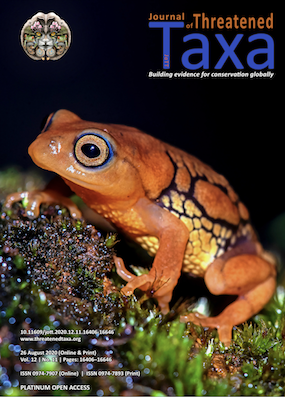Innovative way of human-elephant competition mitigation
Main Article Content
Abstract
Abstract: The negative interaction between humans and elephants is often referred to as conflict, however it is also seen as competition. Human-elephant competition (HEC) is a major protection threat in the fringe villages of the Jaldapara National Park (JPNP) of West Bengal, India. JPNP is facing challenges from the highly populated fringe villages, which exist in elephant corridors. Between 2015 and 2018 there were 12 elephant deaths. During the same period elephants caused 34 human deaths. As per data, most of the elephant interactions occurred in the fringe villages of Madarihat and Jaldapara North Range. Per reports of human deaths, Chekamari and Khairbari villages of Madarihat Range are in the most vulnerable list. Most of the human deaths occurred in the early morning (05.00–06.00 h) and in the evening, when people are going outside for open defecation (OD). On a pilot basis Chekamari and Khairbari villages of Madarihat Range were selected for a door to door household survey with the objective to develop an innovative strategy as a mitigation measure of HEC. The results of the survey show that both villages are tribal and minority population, the socio-economic condition of the people is very poor, on an average 5–6 members are in each household, the source of drinking water is a community well for most of the households, and 50 households are devoid of toilet facilities so automatically the members of those households go outside for OD. Out of the total human deaths, 16 occurred in the Madarihat area; out of these 16 cases, six were from the Chekamari and Khairbari villages. For this reason, between April 2019 to September 2019, with available funds 20 toilets with tube-well were built in the 20 neediest households of these two villages. Due to the communication with the community, behavioural changes were made and their participation for 100% usage of those toilets was assured. After the construction of the toilets until now, no human death cases have been reported.
Article Details
Authors own the copyright to the articles published in JoTT. This is indicated explicitly in each publication. The authors grant permission to the publisher Wildlife Information Liaison Development (WILD) Society to publish the article in the Journal of Threatened Taxa. The authors recognize WILD as the original publisher, and to sell hard copies of the Journal and article to any buyer. JoTT is registered under the Creative Commons Attribution 4.0 International License (CC BY), which allows authors to retain copyright ownership. Under this license the authors allow anyone to download, cite, use the data, modify, reprint, copy and distribute provided the authors and source of publication are credited through appropriate citations (e.g., Son et al. (2016). Bats (Mammalia: Chiroptera) of the southeastern Truong Son Mountains, Quang Ngai Province, Vietnam. Journal of Threatened Taxa 8(7): 8953–8969. https://doi.org/10.11609/jott.2785.8.7.8953-8969). Users of the data do not require specific permission from the authors or the publisher.
References
West Bengal Forest Department (2015). G.O. No. 195-For/11M-95/2011(Pt-I) dated 30.i.2015, www.westbengalforest.gov.in
West Bengal Forest Department (2018). Wildlife Wing G.O. No. 1805-For/o/11M-95/2011 (Pt. I) Kolkata, the 29th October, 2018, www.wildbengal.com
Davidar, P. (2018). The term human-wildlife conflict creates more problems than it resolves: better labels should be considered. Journal of Threatened Taxa 10(8): 12082–12085. https://doi.org/10.11609/jott.4319.10.8.12082-12085 DOI: https://doi.org/10.11609/jott.4319.10.8.12082-12085
Conservator of Forest & Divisional Forest Officer (eds.) (2012). Fifth Working Plan of Wildlife Division-III, Vol. 1. Government of West Bengal, Directorate of Forests, pp. 3–5.

